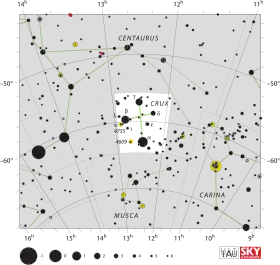Zeta Crucis
Zeta Crucis, ou ζ Crucis, est une étoile binaire de la constellation australe de la Croix du Sud. Elle est visible à l'œil nu avec une magnitude apparente de 4,06. ζ Crucis est située à environ 360 années-lumière du Soleil. Elle est membre du groupe Bas-Centaure Croix du Sud, lui-même partie de l'association Scorpion-Centaure[10].
Zeta Crucis
| Ascension droite | 12h 18m 26,24772s[1] |
|---|---|
| Déclinaison | −64° 00′ 11,0528″[1] |
| Constellation | Croix du Sud |
| Magnitude apparente | 4,04[2] |
Localisation dans la constellation : Croix du Sud  | |
| Type spectral | B2.5V[3] |
|---|---|
| Indice U-B | −0,68[2] |
| Indice B-V | −0,17[2] |
| Vitesse radiale | +15,8 km/s[4] |
|---|---|
| Mouvement propre |
μα = −33,80 mas/a[1] μδ = −10,15 mas/a[1] |
| Parallaxe | 9,12 ± 0,45 mas[1] |
| Magnitude absolue | −1,13[5] |
| Masse | 6,4 ± 0,1 M☉[6] |
|---|---|
| Luminosité | 737 L☉[5] |
| Température | 3 832 K[7] |
| Rotation | 115 km/s[8] |
| Âge | 20,0 ± 4,3 × 106 a[6] |
Autres désignations
ζ Cru, CPD−63 2235, FK5 {{{1}}}, HD 106983, HIP 60009, HR 4679, SAO 251841, GC 16785[9]
C'est une étoile binaire spectroscopique à double spectre[11]. Son spectre est celui d'une étoile blanche de la séquence principale de type spectral B2.5 V. Elle possède un faible compagnon visuel de magnitude apparente 12,49[12].
Références
- (en) F. Van Leeuwen, « Validation of the new Hipparcos reduction », Astronomy & Astrophysics, vol. 474, no 2, , p. 653 (DOI 10.1051/0004-6361:20078357, Bibcode 2007A&A...474..653V, arXiv 0708.1752) Vizier catalog entry
- (en) H. L. Johnson et al., « UBVRIJKL photometry of the bright stars », Communications of the Lunar and Planetary Laboratory, vol. 4, no 99, , p. 99 (Bibcode 1966CoLPL...4...99J)
- (en) W. A. Hiltner, R. F. Garrison et R. E. Schild, « MK Spectral Types for Bright Southern OB Stars », Astrophysical Journal, vol. 157, , p. 313–326 (DOI 10.1086/150069, Bibcode 1969ApJ...157..313H)
- (en) D. S. Evans (juin 20–24, 1966). « The Revision of the General Catalogue of Radial Velocities » Determination of Radial Velocities and their Applications, Proceedings from IAU Symposium no. 30, Université de Toronto: International Astronomical Union. Consulté le 2009-09-10.
- (en) E. Anderson et Ch. Francis, « XHIP: An extended hipparcos compilation », Astronomy Letters, vol. 38, no 5, , p. 331 (DOI 10.1134/S1063773712050015, Bibcode 2012AstL...38..331A, arXiv 1108.4971)
- (en) N. Tetzlaff, R. Neuhäuser et M. M. Hohle, « A catalogue of young runaway Hipparcos stars within 3 kpc from the Sun », Monthly Notices of the Royal Astronomical Society, vol. 410, no 1, , p. 190–200 (DOI 10.1111/j.1365-2966.2010.17434.x, Bibcode 2011MNRAS.410..190T, arXiv 1007.4883)
- (en) M. Gerbaldi,, R. Faraggian et N.Balin, « Binary systems with post-T Tauri secondaries », Astronomy & Astrophysics, vol. 379, , p. 162–184 (DOI 10.1051/0004-6361:20011298, Bibcode 2001A&A...379..162G)
- (en) P. L. Bernacca et M. Perinotto, « A catalogue of stellar rotational velocities », Contributi Osservatorio Astronomico di Padova in Asiago, vol. 239, no 1, , p. 1 (Bibcode 1970CoAsi.239....1B)
- (en) * zet Cru -- Star sur la base de données Simbad du Centre de données astronomiques de Strasbourg.
- (en) Christine H. Chen et al., « A Spitzer MIPS Study of 2.5-2.0 M☉ Stars in Scorpius-Centaurus », The Astrophysical Journal, vol. 756, no 2, , p. 24 (DOI 10.1088/0004-637X/756/2/133, Bibcode 2012ApJ...756..133C, arXiv 1207.3415)
- (en) R. Chini et al., « A spectroscopic survey on the multiplicity of high-mass stars », Monthly Notices of the Royal Astronomical Society, vol. 424, no 3, , p. 1925 (DOI 10.1111/j.1365-2966.2012.21317.x, Bibcode 2012MNRAS.424.1925C, arXiv 1205.5238)
- (en) G. F. Gahm, P. Ahlin et K. P. Lindroos, « A study of visual double stars with early type primaries. I - Spectroscopic results », Astronomy & Astrophysics Supplement Series, vol. 51, , p. 143–159 (Bibcode 1983A&AS...51..143G)
- Portail de l’astronomie
- Portail des étoiles
Cet article est issu de Wikipedia. Le texte est sous licence Creative Commons - Attribution - Partage dans les Mêmes. Des conditions supplémentaires peuvent s'appliquer aux fichiers multimédias.